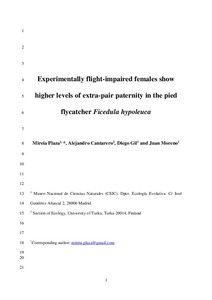Experimentally flight-impaired females show higher levels of extra-pair paternity in the pied flycatcher Ficedula hypoleuca
Plaza Mireia; Cantarero Alejandro; Gil Diego; Moreno Juan
https://urn.fi/URN:NBN:fi-fe2021042823726
Tiivistelmä
There is no consensus yet on the reasons why females engage in extra-paircopulations (EPCs). In some species, females have been shown to accruesome indirect benefits, but these effects are not consistent across speciesand studies. The sexual conflict hypothesis posits that extra-pair paternity(EPP) is the result of strong selection for male pursuit of EPC without realbenefits for females. In order to test this hypothesis, we experimentallyreduced wing area (reversibly tying together some primary feathers), in agroup of pied flycatcher females (Ficedula hypoleuca). The manipulationincreases wing loading (body mass/wing area), which is negatively associ-ated with flying ability, and thus with the capacity to escape from unwantedcopulations. We compared the levels of EPP in this experimental group withthose of a group of un-manipulated females. Experimental females almostdoubled the proportion of extra-pair young (EPY) with respect to controlfemales. In addition, more males sired EPY in experimental than in controlbroods containing EPY. These results suggest that in our study population,EPP could be partially a product of female capacity to avoid EPCs. We alsodiscuss the alternative hypothesis that results might be due to an eventualreduction of female attractiveness
Kokoelmat
- Rinnakkaistallenteet [27094]
